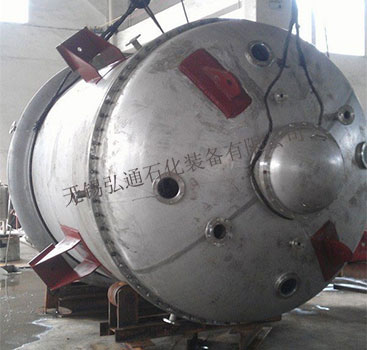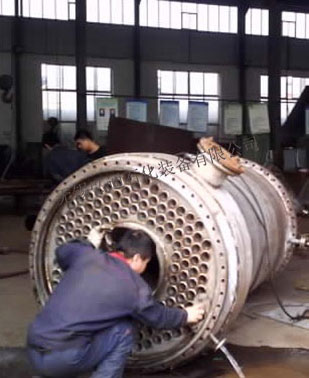- Crystallizer Series
- MVR Evaporators
- Complete System Engineering
- Scraper type film evaporator
- Distillation tower equipment
- Energy-Saving Sewage
- Waste Water Sewage
- Energy-Saving Waste Water
- Reaction & stirring equipment
- Heat-Exchange Condensing
- Drying and Dispersing Equipmen
- Tank Series
- Fermentation Equipment
- Concentration Evaporation Faci
- Extraction, Filtration, Precip
 |
 |
 |
熔融结晶器(静态/动态降膜式)/Melt crystallizer(Static / dynamic falling film type)
熔融结晶目前在中国未大范围应用,因此没有多值得借鉴的工程经验,所以我司熔融结晶器设计要基于天津科技大学结晶过程研究室的熔融结晶工艺开发。请点击熔融结晶工业应用产品统计,也可直接点击网站结晶技术博客查阅相关熔融结晶工艺开发及设备信息。
Melting crystallizer has not been widely used in China at present, so there is no more engineering experience for reference. Therefore, our design of melt crystallizer is based on the melt crystallization process of the Crystallization Process Research Institute of Tianjin University of Science and Technology. Please click on the melt crystallization industrial application statistics, or the website of crystallization technology blog to obtain the relevant melt crystallization process development and equipment information.
Melting crystallizer has not been widely used in China at present, so there is no more engineering experience for reference. Therefore, our design of melt crystallizer is based on the melt crystallization process of the Crystallization Process Research Institute of Tianjin University of Science and Technology. Please click on the melt crystallization industrial application statistics, or the website of crystallization technology blog to obtain the relevant melt crystallization process development and equipment information.
应用范围/Applied Range
熔融结晶器应用于化工中间体、医药中间体、生化制品的高纯度晶体产品的生产。
Melt crystallizer is widely used in the production of chemical intermediates, pharmaceutical intermediates and high purity crystal products of biochemical products.
Melt crystallizer is widely used in the production of chemical intermediates, pharmaceutical intermediates and high purity crystal products of biochemical products.
产品分类/Product Classification
可分为静态熔融结晶器和动态塔式降膜熔融结晶器两种。
It can be divided into two types: high-efficiency static melt crystallizer and dynamic tower falling film melting crystallizer.
It can be divided into two types: high-efficiency static melt crystallizer and dynamic tower falling film melting crystallizer.
结晶器材质/Material
根据物料特性可用材质分为:碳钢、不锈钢及特殊金属材料。
carbon steel, stainless steel and special metal materials.
carbon steel, stainless steel and special metal materials.
熔融结晶器优点/Advantages
① 实用性强,针对不同的工艺要求选用不同类型的设备。
strong practicability, and different types of equipments are selected according to different technological requirements
② 投资费用低,价格仅为国外同类价格的1/5-1/10;国内价格的1/2-1/6。
Low investment cost, the price is only 1/5-1/10 of the same price abroad; 1/2-1/6 of the domestic price
③ 操作弹性大,可自动控制也可手动操作。
Operation flexibility, automatic control and manual operation are both ok.
④ 设备紧凑、合理。
compact and reasonable
⑤ 实际应用效果好,结晶损耗低。
good application effect and low crystallization loss
⑥ 应用熔融结晶工艺可以使有些复杂的工艺变得尤其简单。
Some complex processes become especially simple
strong practicability, and different types of equipments are selected according to different technological requirements
② 投资费用低,价格仅为国外同类价格的1/5-1/10;国内价格的1/2-1/6。
Low investment cost, the price is only 1/5-1/10 of the same price abroad; 1/2-1/6 of the domestic price
③ 操作弹性大,可自动控制也可手动操作。
Operation flexibility, automatic control and manual operation are both ok.
④ 设备紧凑、合理。
compact and reasonable
⑤ 实际应用效果好,结晶损耗低。
good application effect and low crystallization loss
⑥ 应用熔融结晶工艺可以使有些复杂的工艺变得尤其简单。
Some complex processes become especially simple
熔融结晶器缺点/Disadvantages
结晶器的结构相对精馏塔来说,略复杂。需要发汗、洗涤等步骤。过程较复杂,过程的连续化较困难。
The structure of the mold is a little more complicated than that of the distillation column. It needs Sweating, washing, etc. The process is complex and difficult to be continuous.
相对于其它热分离单元操作,熔融结晶具有如下优点:
Compared with other heat separation units, melt crystallizer has the following advantages:
高选择性、低能耗、操作温度低、无溶剂、无废液、无气相。熔融结晶与精馏相比较,具有操作温度低、所需能耗小等突出优点。除以上两点外,第三点就是可以利用工厂里其它操作单元所产生的废热。因为现有的大部分有机化合物的熔点都在工厂废热温度范围内。
High selectivity, low energy consumption, low operating temperature, no solvent, no waste liquid, no gas phase. Compared with distillation, it has many advantages, such as low operating temperature and small energy consumption. Besides, Waste heat from other operating units in the plant can be utilized. Because most of the organic compounds’ melting point is in the range of the waste heat in the factory.
熔融结晶与溶液结晶相比较,由于没有添加新的溶剂,所以避免了溶剂的后处理过程,这个优点往往可以弥补熔融结晶的其它缺点。
Compared with solution crystallization, melt crystallization avoids the post treatment process of the solvent without adding new solvent, and this advantage can often compensate for other shortcomings of the melt crystallization.
熔融结晶处理的是液态物质,液态相对于气态而言,所需要的体积小,所用设备体积小,投资少。当然,如果熔融结晶需要长的停留时间时,则这点优势就不明显了。熔融结晶过程没有气体产生,泄露易于控制。而且整个设备可密闭,有利于环境安全。熔融结晶不需要添加任何物质,所以没有废液和其它化学物质(溶剂)产生。要知道,溶剂回收的成本往往占整个结晶成本的大部分。对于非固体溶液型体系,从理论上来说,结晶过程具有高的选择性和高的产品纯度。
Melt crystallizer deals with liquid substance, which requires a small size and a small amount of equipment, therefore needs less investment. However, if melting crystallization takes longer residence time, then this advantage is not obvious. During crystallization, no gas is produced, and leakage is easy to control. Moreover, the whole equipment can be closed and is more conducive to environmental safety. Molten crystallization does not require the addition of any substance, so no waste liquid or other chemical substance (solvent) is produced. The cost of solvent recovery often accounts for most of the cost of the crystallization process. For the non solid solution type system, the crystallization process has high selectivity and high product purity.
The structure of the mold is a little more complicated than that of the distillation column. It needs Sweating, washing, etc. The process is complex and difficult to be continuous.
相对于其它热分离单元操作,熔融结晶具有如下优点:
Compared with other heat separation units, melt crystallizer has the following advantages:
高选择性、低能耗、操作温度低、无溶剂、无废液、无气相。熔融结晶与精馏相比较,具有操作温度低、所需能耗小等突出优点。除以上两点外,第三点就是可以利用工厂里其它操作单元所产生的废热。因为现有的大部分有机化合物的熔点都在工厂废热温度范围内。
High selectivity, low energy consumption, low operating temperature, no solvent, no waste liquid, no gas phase. Compared with distillation, it has many advantages, such as low operating temperature and small energy consumption. Besides, Waste heat from other operating units in the plant can be utilized. Because most of the organic compounds’ melting point is in the range of the waste heat in the factory.
熔融结晶与溶液结晶相比较,由于没有添加新的溶剂,所以避免了溶剂的后处理过程,这个优点往往可以弥补熔融结晶的其它缺点。
Compared with solution crystallization, melt crystallization avoids the post treatment process of the solvent without adding new solvent, and this advantage can often compensate for other shortcomings of the melt crystallization.
熔融结晶处理的是液态物质,液态相对于气态而言,所需要的体积小,所用设备体积小,投资少。当然,如果熔融结晶需要长的停留时间时,则这点优势就不明显了。熔融结晶过程没有气体产生,泄露易于控制。而且整个设备可密闭,有利于环境安全。熔融结晶不需要添加任何物质,所以没有废液和其它化学物质(溶剂)产生。要知道,溶剂回收的成本往往占整个结晶成本的大部分。对于非固体溶液型体系,从理论上来说,结晶过程具有高的选择性和高的产品纯度。
Melt crystallizer deals with liquid substance, which requires a small size and a small amount of equipment, therefore needs less investment. However, if melting crystallization takes longer residence time, then this advantage is not obvious. During crystallization, no gas is produced, and leakage is easy to control. Moreover, the whole equipment can be closed and is more conducive to environmental safety. Molten crystallization does not require the addition of any substance, so no waste liquid or other chemical substance (solvent) is produced. The cost of solvent recovery often accounts for most of the cost of the crystallization process. For the non solid solution type system, the crystallization process has high selectivity and high product purity.